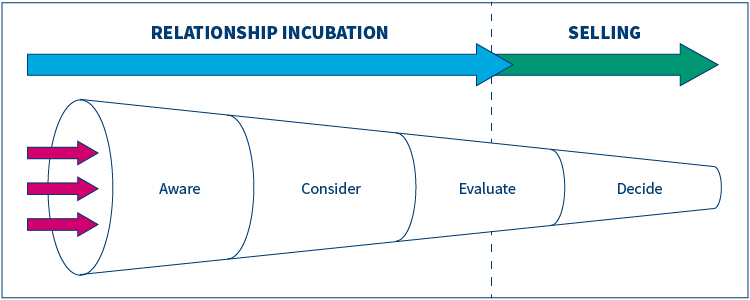Upreaching to higher level decision makers is important. Don’t make these common mistakes.
We call it “upreaching”— reaching higher into your customer organizations than your typical customer contact. And in most—if not all—B2B markets today, upreaching is important for building a more strategic relationship with the executive decision makers and true economic buyers within your target customers.
Why is upreaching an important strategy?
Companies look to establish more consistent procurement strategies that build on efficiencies and are more aligned with corporate business strategies and goals. The inevitable outcome is that your target customers are, more and more, looking to reduce their suppliers down to a more manageable, tightly controlled number. The 2016 Indirect Spend Management Benchmark Study by Denali Group revealed that Supplier Consolidation was tied as the number one top initiative for creating value.
Meanwhile, technology purchase decisions, which used to be almost solely within the jurisdiction of technology organizations (such as IT, R&D, etc.) are now involving more of the company’s business executives. In fact, the 2016 B2B Tech Purchase Study by CBSi shows that a full 40% of the technology decision team today is made up of business decision makers.
To maintain a competitive edge and ensure that your organization makes it onto that shortening list of strategic, preferred suppliers, marketing and sales organizations need to develop efforts together to reach higher up into their customer bases—establishing and incubating strategic relationships with corporate executive decision makers and their key influencers.
But implementing such a strategy is rife with challenges and mistakes that can thwart the success of these upreaching initiatives.

Why marketing efforts to executives can often fail
We have identified six common reasons why marketing initiatives targeting executive decision makers can often fail:
1. You’re relying too much on traditional approaches.
Traditional “wide-net” marketing approaches involve those commonly used lead generation programs and broad-based marketing communications (email, advertising, direct mail, etc.). These marketing vehicles and tools are typically designed to reach hundreds if not thousands of contacts in hopes that your communications and offers gain traction and response from new customer prospects.
While these tactics may occasionally reach executives, you’re likely going to be more effective in your upreaching efforts if you use a person-to-person (P2P) approach: identify a smaller number of executive contacts, and seek to establish and incubate a personal, trusted relationship at the strategic level.
2. You're pitching product features and benefits—and not your strategic value.
So much of marketing has for years been focused on enabling sales organizations to better pitch product features and benefits. Sales guides, sales training, product brochures, sales battle cards, and data sheets are very often aimed at helping salespeople communicate the superiority of products and services, their robust features, and the benefits of those features.
But when reaching business executives at higher levels, you need to focus your initial approach on communicating your strategic value to the organization—and to the executive. You won’t get the opportunity to discuss your products or services until you first convince the executive that you have strategic value that the organization (and the executive) may benefit from. You need to understand the filtering that your target executives use to decide if you’re worth talking to.
3. Your approach doesn’t match their buying journey.
Today more than ever, executive decision makers have easy access to detailed information, recommendations, and purchase advice on just about every product and service their organization may need. At the touch of a finger, they can access industry reports, white papers, analyst recommendations, customer success stories and testimonials, competitive profiles and comparisons, benchmark data and other test results, video demonstrations, and free trials.
It should be no surprise, then, that today’s executive decision makers are very selective about when and how they engage with potential vendors. B2B marketers need to adjust their strategies to match the way customers want to work.
But the real issue isn’t necessarily that you’re reaching customers too early—it’s often because you’re taking the wrong approach. Decision makers will want to hear from you if (and only if) what you offer them is of value to the specific stage of their buyer’s journey. That means, in most cases, you need to stop trying to sell products and services in the early stages of their journey—and instead, provide information that helps inform them in a manner that assists their journey.
Reaching your true decision makers early in the buyer’s journey with the right approach can pay off. According to InsideSales.com, approximately 50% of sales go to the first person who calls on the prospect. And in a recent survey by SiriusDecisions of over 1,000 buyers, roughly 60% indicated that they or someone from their organization received information from the winning vendor to help inform them in the earliest educational stages of their buying journey.
4. The value you're communicating isn't focused on strategic outcomes—or isn't relevant to a current problem or challenge.
If you want to get the executive’s attention and
mindshare, you first need to know what keeps them up at night. That is, you must confidently understand the most critical business challenges that your executive decision makers face. And then you must be able to succinctly help them understand what makes you uniquely qualified to best address those challenges better than their alternative choices. (And by alternative choices, we don’t just mean your competitors—but also (a) the decision to do it themselves in-house, and (b) the decision to do nothing.)
To do this, you need to focus your messaging on the true strategic value that you offer and its ability to directly help their company (and the executive) drive a strategic outcome.
5. You're not communicating your value upfront.
Look at your current customer sales presentation deck. Do the first few slides talk all about your company—its history, size and/or growth, market presence, global reach, sample customers, or perhaps your recent awards—then move immediately into your product/solution discussion?
This is a very common mistake—and, fortunately, one that is very easy to fix. Most customers—especially executives—have very little interest in knowing those things about you until they believe you potentially have strategic value relevant to the critical needs of their company. If your presentations and sales tools don’t focus on establishing your strategic value right up front, you need to seriously consider revamping those sales tools.
6. You're telling them something they can readily hear from their current trusted relationships.
Executives have a wide range of trusted relationships they can tap into for information, advice, guidance, and recommendations. This may include the various subject matter experts that work for them, other executives within the company, peers within the industry, analysists and consultants, and other experts they’ve gotten to know through the years. When you’re approaching executives, your goal should be to tell them something they won’t hear from their current trusted relationships. Leverage your industry or customer insights and perspectives to say something attention-grabbing that relates to their most critical business needs and challenges. Offer to present a customer’s story that they can relate to. Challenge a long-accepted assumption—or offer to showcase a new approach.
We offer a number of related blog articles to assist you further in understanding how to better implement an upreach focus into your marketing and sales initiatives. Besides the articles mentioned earlier, here are two more you may want to read:
- Becoming the invisible marketer—Discusses the need to build marketing initiatives that blend seamlessly into (versus interrupting) the customer’s normal conversation path, encouraging an engagement that feels more natural and organic—and less processed through the marketing machinery.
- Merging with the conversation highway—Instead of simply focusing on interruptive marketing efforts to gain customer attention, you need to understand how to join them in these ongoing conversations—in essence, to merge smoothly with the “conversation highway” so your engagements with prospective customers are organic and don’t feel forced.


